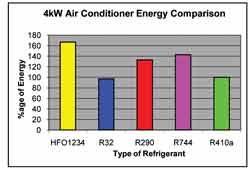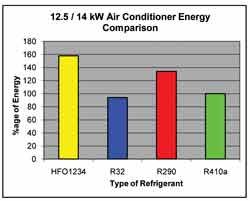IN AN advisory paper to the European Commission, AREA has promoted the continuing use of HFCs, questioned the effectiveness of so-called 'drop in' replacements for R22 and predicted a massive reduction in greenhouse gas emissions as a result of the F-gas regulations.
The paper supplied to the EC in June by the European acr contractor organisation states its position on the issue of refrigerants, their use, phase-out and alternatives.
AREA says it accepts that there are numerous applications where [natural] alternatives are desirable from political and environmental perspectives but maintains that there are also applications where it is beneficial to retain the use of HFCs.
Alternatives
In respect of R22 alternatives, AREA appears far from convinced of the effectiveness of certain fluorinated blends used as retrofit 'drop in' replacements. AREA maintains that use of these refrigerants has shown 'varied results' across Europe due to a tendency to leak.
According to AREA, the reason for this is the molecular structure of the 'drop in' being much smaller than both the HCFC it replaces and the OFN used to pressure test the system. Efficiency drops are also said to have been well documented.
While AREA sees small systems, such as domestic refrigerators and freezers and point of sale display fridges showing good efficiencies with hydrocarbon (HC) refrigerants, it acknowledges CO2 or ammonia as being the preferred refrigerant in large central plant systems.
These, says AREA, have documented efficiency benefits over both HFCs and HCs in large applications.
However, the Association points out that between these large and small acr systems there is a huge range of cooling and heating equipment where HFCs have been proven to be the most energy efficient option.
Test evidence
As evidence of the efficiency of HFCs in these systems, AREA has referred to data from comparative tests carried out by The Japan Refrigeration and Air Conditioning Industry Association (JRAIA).
These results from tests on 4kW and 14kW room air conditioners are shown in graph form here (figs 1 and 2).

Fig 1: Comparative efficiencies of refrigerants in a 4kW ac system

Fig 2; Comparative efficiencies of refrigerants in a 12.5-14kW ac system
Tests on the 4kW unit shows R410A as far more efficient than CO2 (R744), HC (R290) or HFO refrigerants. Compared to R410A, HC uses 33% more energy, CO2 uses 43% more energy and the HFO uses 67% more energy to achieve its cooling duty.
Fig 2, again, shows HFCs to be more efficient. Propane uses 34% more energy and the HFO 58% more energy than R410A. As in the 4kW test, R32 is slightly better (by 6%) purely in terms of energy efficiency, but is not regarded as being suitable for DX applications such as these due to the high operating pressure.
AREA also points out to the EC that as the compressor duty of many of the domestic heat pumps being installed across the EU fall into the same range of heat exchanger compressor duty as the 14kW, R410A would return similar results for this renewable technology as well.
Massive reduction in HFC leaks
With the implementation of the F-gas regulations AREA predicts a massive reduction in greenhouse gas emissions directly from acr systems.
Much of the reported leakage to date, it points out, has come from car ac, an industry which is already working towards phasing out HFCs. The majority of the balance of the leakage to date has tended to come from the supermarket industry, which has itself been actively working towards a voluntary phase out of HFCs towards large CO2 plant.
'When the GWP of the substance is irrelevant we can concentrate on the more important factors of efficiency and, therefore, CO2 emissions from power stations,' says the report maintaining that this is a far bigger contributor to GHG levels worldwide than stationary acr equipment by a factor of around 80.